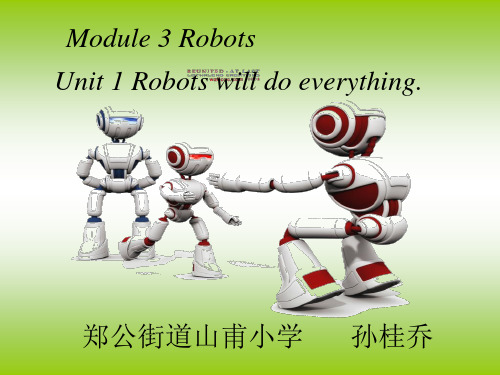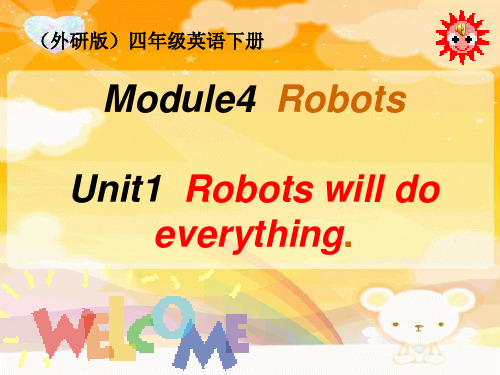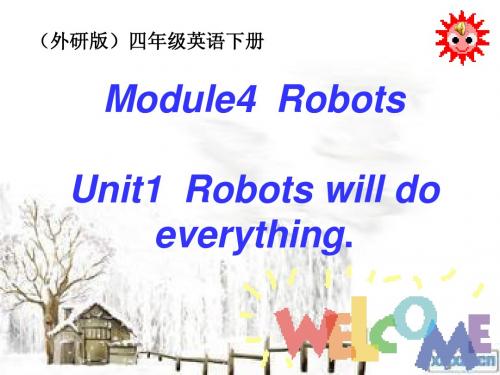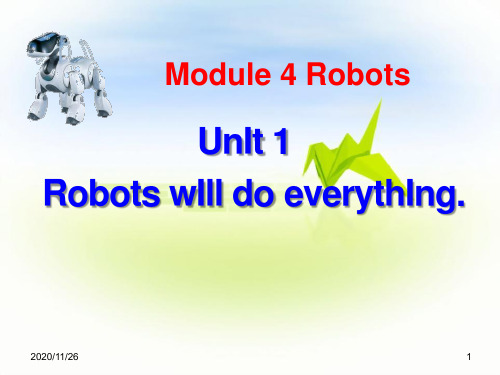外研版小学英语四年级下册《Module 4 Robots》(Unit1)ppt课件
- 格式:ppt
- 大小:1.51 MB
- 文档页数:20

外研社(三起)四年级英语第四册:Module 4 Robots Unit 1 Robots will do everything 教案教学目标•能够听懂并理解关于机器人的简单英文对话。
•能够用简单的英语表述机器人以及它们可以完成的任务。
•能够与同伴合作完成机器人的设计和介绍。
•通过本单元的学习,拓展学生的知识面,激发学生的创新思维,培养学生的英语交流能力和合作意识。
教学重点•能够听懂并理解关于机器人的简单英文对话。
•能够用简单的英语表述机器人以及它们可以完成的任务。
教学难点•能够与同伴合作完成机器人的设计和介绍。
教学准备•教材:外研社(三起)四年级英语第四册 Module 4 Robots Unit 1。
•大屏幕、投影仪等教学设备。
•学生们自己带来的废旧材料、未成型材料等,用于机器人的设计制作。
教学过程导入(5分钟)1.教师简单介绍机器人的发展历程,并展示一些与机器人有关的图片或视频,激发学生对机器人的兴趣和好奇心。
呈现(15分钟)1.教师放映课文 Unit 1 Robots will do everything 的视频,引导学生听视频中机器人相关的对话。
2.教师根据视频展示关键词汇:robot, do housework, do the dishes, do the laundry, cook, take care of children, walk the dog 等,并通过图片、动作等方式模拟机器人的各项任务,提高学生对这些任务的理解。
合作探究(20分钟)1.教师告知学生,他们需要分为若干小组,每组设计一个未来的机器人,并为机器人取一个英文名称。
2.学生们自己带来废旧材料等,根据小组的设计图纸开始机器人的设计和制作。
3.在制作过程中,教师为学生们提供必要的指导,督促学生们积极参与制作,呈现他们的天马行空的创意。
4.设计完成后,每个小组需要介绍他们的机器人的名称、功能、外形等英文特点。
学生可以通过图片、口语交流等方式进行展示。




(外研版)三年级起点第四册教案Module 4 RobotsUnit 1 Robots will do everything.Function: Describing things in the future and talking about abilitiesTeaching points: 1.Sentences: One day, robots will do everything.2. Words and phrases: robot everythingone day housework learn our that3. Using will to describe things in the futureTeaching properties: cards tape-recorder CAITeaching procedures:(1) Warming up: ---Greeting.---Listen and act : e.g. wash clothes watch TV run walk play the flute play football jump do homework make a cake row a boat play table tennis (运用肢体语言来复习动词及动词词组,为本课will 的学习做好铺垫)(2) Presentation: Show a robot to the class and say “Today we’re going to talk about the r obots.”Describing the robots, it can sing. It can dance. One day, robots will do everything. (运用图片展示robot的含义)Ask to the stud ents “What else will the robots do?” Show the CAI to students. (让学生看课件了解机器人能做什么不能做什么)Now show the text to the students. Look at the book and ask. What can Daming’s robot do? Will robots do the housework? Will robots help children learn?...Write the answers on the board: It can walk.Then drill this sentence and then change the word “walk”.Talk about the sentences: They will do the housework. They will help children learn.Write the sentence on the board One day, robots will do everything. (用磁卡带替换动词及动词词组,让学生运用所学。

(外研版)四年级英语下册教案Module4Module 4 Robots 单元分析本模块由unit1Robots will do everything和 unit2 Will it be windy in Beijing两个单元组成。
分别向我们介绍怎样用‘will’谈论将来可能发生的事情;运用动词‘can ’描述能力;谈论将来的天气状况等等。
解释‘rain’与‘rainy’的区别:‘rain’所指的是短时性的降雨,而‘rainy’的意思是“多雨的”,指的是一段时期内的气候特征。
与它一样的还有‘snow’与‘snowy’的区别。
Unit 1 Robots will do everything.Teaching aims: It can walk .Robots will do everything.Teaching Importance and difficulties:How to use 'will'and 'can'?Teaching tools:RecorderTeaching steps:step1: Warm up1)Sing a song2) On the board draw a robot (draw a square for the head, rectangle for the body, rectangles for the arms and legs, squares or rectangles for the eyes, nose and mouth on the head).3)Then write 'It can...'under the picture.4)Point to the robot and say,'This is a robot.'Have the students repeat the sentence .Then say, 'It can walk' and begin to walk around the class.Try to walk in a very awkward'robot'way.(do more example by pointing to the robobt and saying,'It can...'and then miming the action.)5) Now have individual students say something they think the robot can do and you have to mime the action.6)Have pairs of students come to the front .Student Asays what the robot can do and StudentB does the action. You may want to write a list of suitable verbs on the board. Step 2: Learning and practising1)Have the students look at the pictures.Ask questions in Chinese ,e.g. What is Samlooking at in picture 1? What is the robot doing in picture2? What has the robot done in the last picture?2)Now say that you are goint to call out the names of different objects and people in the pictures and the students have to point to them.3)Point and sayExplain to the students that you are going to point to the different pictures in Acitivity 3 and make statements about them . They have to tell you if they are true or false by calling out'True'or'False'.(do a lot examples with the class.)4)Now have the students sontinue the activity in pairs.After three turns,they should swap roles.Step 3 : Homework。
(外研版)三年级起点第四册教案Module 4 RobotsUnit 1 Robots will do everything.Function: Describing things in the future and talking about abilitiesTeaching points: 1.Sentences: One day, robots will do everything.2. Words and phrases: robot everythingone day housework learn our that3. Using will to describe things in the futureTeaching properties: cards tape-recorder CAITeaching procedures:(1) Warming up: ---Greeting.---Listen and act : e.g. wash clothes watch TV run walk play the flute play football jump do homework make a cake row a boat play table tennis (运用肢体语言来复习动词及动词词组,为本课will 的学习做好铺垫)(2) Presentation: Show a robot to the class and say “Today we’re going to talk about the r obots.”Describing the robots, it can sing. It can dance. One day, robots will do everything. (运用图片展示robot的含义)Ask to the stud ents “What else will the robots do?” Show the CAI to students. (让学生看课件了解机器人能做什么不能做什么)Now show the text to the students. Look at the book and ask. What can Daming’s robot do? Will robots do the housework? Will robots help children learn?...Write the answers on the board: It can walk.Then drill this sentence and then change the word “walk”.Talk about the sentences: They will do the housework. They will help children learn.Write the sentence on the board One day, robots will do everything. (用磁卡带替换动词及动词词组,让学生运用所学。
(外研版)四年级英语下册教案Module4Module 4 Robots 单元分析本模块由unit1Robots will do everything和unit2 Will it be windy in Beijing两个单元组成。
分别向我们介绍怎样用‘will’谈论将来可能发生的事情;运用动词‘can ’描述能力;谈论将来的天气状况等等。
解释‘rain’与‘rainy’的区别:‘rain’所指的是短时性的降雨,而‘rainy’的意思是“多雨的”,指的是一段时期内的气候特征。
与它一样的还有‘snow’与‘snowy’的区别。
Unit 1 Robots will do everything.Teaching aims: It can walk .Robots will do everything.Teaching Importance and difficulties:How to use 'will'and 'can'?Teaching tools:RecorderTeaching steps:step1: Warm up1)Sing a song2) On the board draw a robot (draw a square for the head, rectangle for the body, rectangles for the arms and legs, squares or rectangles for the eyes, nose and mouth on the head).3)Then write 'It can...'under the picture.4)Point to the robot and say,'This is a robot.'Have the students repeat thesentence .Then say, 'It can walk' and begin to walk around the class.Try to walk in a very awkward'robot'way.(do more example by pointing to the robobt and saying,'It can...'and then miming the action.)5) Now have individual students say something they think the robot can do and you have to mime the action.6)Have pairs of students come to the front .Student Asays what the robot can do and StudentB does the action. You may want to write a list of suitable verbs on the board.Step 2: Learning and practising1)Have the students look at the pictures.Ask questions in Chinese ,e.g. What is Sam looking at in picture 1? What is the robot doing in picture2? What has the robot done in the last picture?2)Now say that you are goint to call out the names of different objects and people in the pictures and the students have to point to them.3)Point and sayExplain to the students that you are going to point to the different pictures in Acitivity 3 and make statements about them . They have to tell you if they are true or false by calling out'True'or'False'.(do a lot examples with the class.)4)Now have the students sontinue the activity in pairs.After three turns,they should swap roles.Step 3 : Homework。